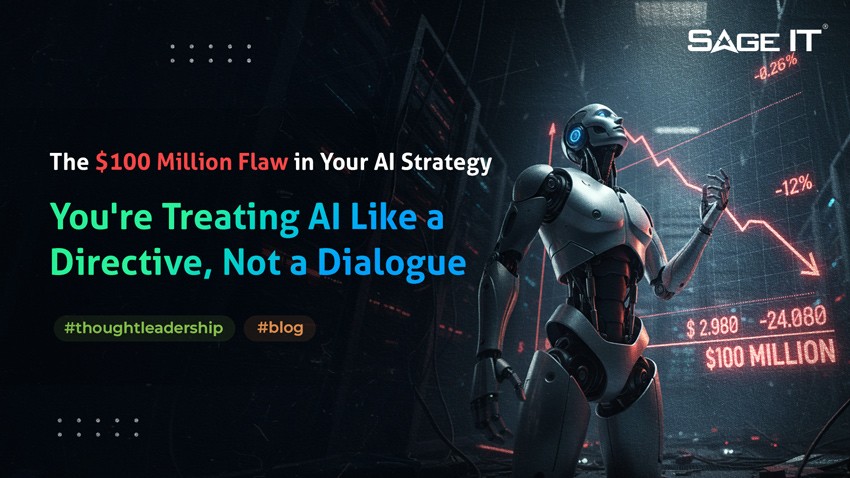Most corporate AI transformations fail before they even start, not because of the technology but because of the management model.
Leaders architect for compliance, not co-creation. They issue commands when what AI truly needs is conversation.
Artificial intelligence doesn’t thrive in command structures; it thrives in communication cultures. When organizations fail to listen, they accumulate AI Debt, the compounding cost of missed efficiency, stifled innovation, and talent churn that arises when powerful tools are underutilized or mistrusted.
Across industries, AI is delivering step-changes in performance: one large consumer brand reduced average resolution time from ~11 minutes to ~2 minutes, a healthcare operations provider saved 15,000+ hours per month and cut documentation time by 40% with AI document processing.
Just like financial debt, AI Debt compounds fastest in rigid hierarchies, where communication bottlenecks choke learning and experimentation.
The AI–Hierarchy Paradox: Why Top-Down Models Inevitably Stall Innovation
Too many AI transformations begin with top-down fanfare; a major announcement, an expensive vendor, a pilot, and then silence. Adoption plateaus, ROI fades, and employees disengage.
This isn’t a change management issue. It’s a communication architecture failure.
When AI is mandated rather than co-created, psychological safety collapses. Employees default to safety-seeking behavior, hiding experiments, withholding critique, and limiting their use of AI to what is explicitly sanctioned.
Innovation accelerates when employees feel safe sharing even unpolished ideas.
Innovation can’t thrive in a climate of quiet compliance. It flourishes only when people feel free to share, test, and challenge ideas without fear of reprimand or irrelevance.
The result isn’t just slower AI adoption; it’s a silent erosion of insight and initiative.
The Hidden Cost of Silence
But silence can be redesigned. Communication can be coded into the culture if leaders are deliberate about it. Reversing that silence isn’t about communication training; it’s about re-architecting how intelligence moves through the organization.
Five Moves to Flatten Communication and Accelerate AI
Flattening communication doesn’t mean removing structure; it means removing friction. These five leadership shifts help organizations create the conditions where ideas can move as fast as technology.
1. Architect Listening Infrastructure
Don’t rely on periodic surveys or top-down reports. Build perpetual listening posts such as digital suggestion boxes, “What If?” town halls, and monthly Ask-Me-Anything sessions.
Leaders shouldn’t show up to defend; they should show up to discover.
2. Build a Living Knowledge Network
Make AI learning lateral, not vertical.
Encourage departments to share use cases through newsletters, internal demos, and peer partnerships. Pair AI enthusiasts with curious peers.
You’ll create a decentralized, evolving knowledge graph, where innovation compounds organically.
3. Glorify the Grassroots Innovator
When an intern builds a chatbot that reduces onboarding time, glorify it. Host demo days. Spotlight small wins. Gamify experimentation.
When creativity is rewarded, rather than reprimanded, you turn experimentation into culture.
4. Institutionalize the ‘No-Blame’ Sandbox
Too many ideas suffocate in the approval gap.
Create safe-to-try zones such as AI sandboxes, microgrants, and shared prompt libraries where employees can test, learn, and fail forward.
Empowerment scales faster than permission.
5. Re-skill Managers as Empathy Nodes
Middle managers are your most critical communication nodes.
Train them not just to cascade strategy but to translate it. They must explain AI with empathy, gather frontline feedback, and channel insights upward.
The next generation of AI-ready leaders won’t just understand algorithms; they’ll understand emotion.
These shifts aren’t cosmetic. They are structural rewires of how intelligence truly scales.
Leading in the Age of AI
In AI transformation, your communication architecture is as important as your data architecture.
The best AI leaders aren’t just strategists; they are conversation architects.
They ask:
- What are employees discovering that we didn’t plan for?
- Where is fear silencing innovation?
- How can we make dialogue as frictionless as data flow?
And then, they listen.
Because the best AI models are open source.
The most effective AI cultures are open dialogue.
At its core, AI leadership is no longer about oversight; it’s about orchestration.
Real AI transformation is less about authority and more about shared authorship.
Closing Thought
AI’s ultimate power lies not in its processing speed, but in its capacity to democratize insight.
The next competitive advantage won’t come from how fast your models learn, but from how bravely your people connect, challenge, and share.
Stop issuing commands. Start architecting the conversation.











